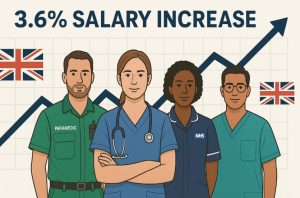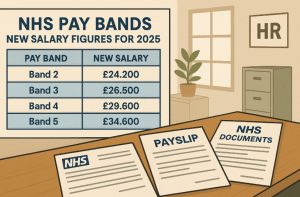Understanding when the NHS pay rise for 2025 will be paid is crucial for healthcare workers across England. With recent announcements confirming an above-inflation increase under the Agenda for Change framework, staff are keen to know when the changes will take effect and how backdated payments will be handled.
This guide outlines the confirmed timelines, salary adjustments, and what the new pay structure means for NHS employees. Stay informed on when you can expect to see the updated figures in your payslip.
What Is The Confirmed NHS Pay Rise For 2025 To 2026?

The UK Government has officially confirmed a 3.6% pay rise for all NHS staff employed under the Agenda for Change (AfC) agreement for the financial year 2025 to 2026. This follows the 5.5% increase implemented in 2024 and demonstrates a continued effort to bring NHS pay closer in line with inflation and the cost of living.
Agenda for Change is the national pay system covering more than one million NHS staff members in England. This includes nurses, midwives, healthcare support workers, physiotherapists, and numerous other clinical and non-clinical roles.
The increase is a response to ongoing workforce challenges and aims to make public healthcare careers more financially sustainable and attractive.
These consecutive above-inflation pay rises aim to:
- Restore earnings value lost in previous years
- Help retain experienced professionals
- Support recruitment targets across NHS England
The 3.6% uplift reflects a significant investment by the government to ensure that NHS staff are fairly compensated for their contribution to national healthcare delivery.
When Will NHS Staff See The Pay Rise In Their Salaries?
NHS employees will begin receiving the 2025–2026 pay increase from August 2025. This marks an improvement on the 2024 timeline, when the pay rise was introduced in October. By accelerating the process, the government intends to ease financial pressures on NHS workers and show a tangible commitment to improving public sector pay conditions.
Payroll departments across NHS Trusts have been instructed to prepare for the earlier disbursement. Most eligible staff will see the revised salaries in their August pay packets, and Human Resources teams will begin communicating detailed timelines by July.
The earlier payment reflects the new ambition from the Department of Health and Social Care to bring forward future pay rounds, starting with negotiations for 2026 in July 2025.
Will NHS Staff Receive Backdated Pay In 2025?
Yes, all eligible staff will receive backdated pay, calculated from 1 April 2025. The back-pay ensures that staff receive the full financial benefit of the pay rise, even though it will not be processed through payroll until August.
The back-pay will be issued as a lump sum in most cases and may include:
- Basic salary adjustments from April to July
- Proportional increases for enhanced hours (e.g. night shifts, weekends)
- Adjustments to related benefits, such as overtime and unsocial hours payments
Back-pay will be included in the August payroll or in a separate off-cycle payment, depending on the NHS Trust’s internal process.
What Are The Updated NHS Salary Bands For 2025?

The 3.6% uplift has been applied across all pay bands under the Agenda for Change structure. Below is a table highlighting the key changes to some of the most commonly referenced salary bands:
NHS Starting Salary Comparison Table
| Band | 2022–2023 Salary | 2024–2025 Salary | 2025–2026 Salary |
| Band 2 | £20,270 | £23,450 | £24,465 |
| Band 3 | £21,730 | £25,392 | £26,305 |
| Band 4 | £24,882 | £28,407 | £29,430 |
| Band 5 | £27,055 | £29,934 | £31,050 |
| Band 6 | £33,706 | £36,666 | £37,987 |
| Band 7 | £41,659 | £44,602 | £46,211 |
These adjustments mean that, for example, a Band 2 employee starting in 2025 will earn over £4,000 more annually than a new starter in 2022. Similarly, Band 5, which includes newly qualified nurses, will now start at around £31,050.
Are There Plans To Change The NHS Pay Structure In The Future?
Beyond the 2025–2026 increase, the government has committed to reforming the Agenda for Change pay structure. This plan, set to be developed over the next 12 months, will involve collaboration between NHS Employers, trade unions, and the NHS Staff Council.
The key goals of the reform include:
- Simplifying the pay progression system
- Improving clarity on career advancement
- Aligning pay with evolving job responsibilities
- Addressing inconsistencies between roles and pay bands
These structural changes are expected to be implemented in the 2026 to 2027 pay round. The Department of Health and Social Care has accepted the Pay Review Body’s recommendation to fund these changes as part of its long-term workforce improvement plan.
How Is The Government Improving NHS Staff Working Conditions?
In addition to salary increases, the government has unveiled several initiatives designed to enhance the working environment for NHS staff. These measures are aimed at improving wellbeing, job satisfaction, and long-term retention.
Key actions include:
- Introducing legislation to criminalise the misuse of the title “nurse” by unqualified individuals
- Launching a national strategy to tackle workplace violence against NHS personnel
- Increasing investment in mental health and wellbeing services for frontline workers
- Improving access to flexible working arrangements, including part-time and remote roles
- Funding upgrades to the job evaluation system to ensure fair grading and pay
The intention is to create a working culture in the NHS that values staff contributions beyond pay, by improving safety, support, and work-life balance.
What Long-Term Improvements Are Planned For NHS Pay And Conditions?

The 2025 pay rise is only one element of a broader, long-term approach to reforming NHS employment conditions. The UK Government, in collaboration with NHS Employers and the NHS Staff Council, has committed to a series of structural and strategic improvements aimed at creating a more sustainable and attractive workforce model for the future.
These improvements fall under the wider “Plan for Change,” which focuses on not only rewarding NHS workers fairly but also rebuilding trust and professionalism in the public health sector. A significant part of this transformation is addressing the root causes of workforce instability, such as inconsistent career progression, unclear job roles, and outdated pay structures.
The most notable long-term improvements include:
- Earlier Pay Round Timelines: The government has announced its intention to start future NHS pay rounds earlier, with the next one beginning in July 2025 for the 2026 to 2027 period. This shift will allow for faster agreements, reducing delays in salary implementation and avoiding the need for backdated payments.
- Agenda For Change Reform: A full-scale review of the Agenda for Change pay structure is underway. Planned for implementation in 2026–2027, the reform aims to simplify pay bands, reduce overlap, and better reflect the responsibilities and competencies required in modern healthcare roles.
- Career Development And Progression Clarity: There will be an increased focus on transparent promotion routes and clearer pathways for career advancement. This aims to address long-standing frustrations among NHS workers who feel stuck in roles with limited growth opportunities.
- Investment In Training And Upskilling: The government is allocating funding for additional professional development, including specialised training programmes, digital skills, and clinical leadership tracks. This is meant to equip staff for evolving demands in healthcare delivery and technology.
- Fair Evaluation Of Roles: Reforms to the national job evaluation system are being prioritised to ensure that NHS workers are accurately and fairly assessed and paid according to the true scope of their responsibilities. This will also help correct pay disparities across similar roles.
- Improved Staff Engagement: Workforce reform will include increased consultation with frontline staff and union representatives to ensure that policies are shaped by those directly affected. This participatory model is expected to improve morale and foster long-term retention.
These long-term improvements are being introduced in response to consistent calls from unions, NHS employees, and healthcare analysts for more meaningful reform in public health employment practices. They are designed to make working in the NHS not only financially viable but also professionally rewarding, contributing to a more resilient and future-ready health system.
How Does The 2025 NHS Pay Rise Compare To Inflation?
One of the most frequently asked questions surrounding the 2025 NHS pay rise is whether it keeps up with inflation—and whether it represents a real-terms gain for NHS employees. The answer, based on available data, is yes: the 3.6% pay uplift confirmed for 2025 to 2026 outpaces the most recent Consumer Price Index (CPI) forecasts, which sit at approximately 2.3% for the year.
In previous years, NHS workers experienced real-term pay erosion due to inflation significantly outpacing wage increases. For example, in 2022, CPI inflation peaked at over 9%, while NHS pay rose by only 3%. This led to widespread concerns over affordability, staff attrition, and workforce morale.
The 2025 increase represents a reversal of that trend. Here’s a closer look at how the NHS pay rises compare to inflation in recent years:
NHS Pay Rise Compared To Inflation
| Financial Year | NHS Pay Rise | CPI Inflation Rate | Real-Term Outcome |
| 2022–2023 | 3.0% | 9.1% | Real-term pay cut |
| 2023–2024 | 5.0% | 6.8% | Marginal real-term loss |
| 2024–2025 | 5.5% | 3.4% | Real-term pay gain |
| 2025–2026 | 3.6% | 2.3% | Real-term pay gain |
The above-inflation increase for 2025 helps restore some of the purchasing power NHS workers lost during the peak of the cost-of-living crisis. While this year’s pay rise may not fully compensate for all previous losses, it marks a step in the right direction in re-establishing wage stability in the public sector.
The timing of the pay increase—set to appear in August payslips and backdated to April—also aligns well with inflation trends. Many economists predict continued moderation in inflation through 2025, meaning the uplift will likely retain more of its value than in earlier years.
Additionally, with plans to negotiate the 2026 pay round as early as July 2025, future NHS pay awards may be better aligned with inflation forecasts, further enhancing the real-term value of NHS salaries.
In essence, the 2025 pay rise not only exceeds inflation but also signals a more proactive and responsive pay strategy, one that may finally begin to restore long-term confidence among NHS professionals.
What Does This Pay Rise Mean For NHS Recruitment And Retention?

Improved pay and working conditions are expected to strengthen recruitment pipelines and reduce attrition across the NHS. This is particularly critical in clinical roles such as nursing and paramedicine, where workforce shortages remain severe.
The combination of fairer pay, earlier disbursement, and a more supportive work environment is intended to:
- Increase appeal of NHS careers to new graduates and school leavers
- Encourage retention of mid-career professionals at risk of burnout or career change
- Attract former NHS staff back into the system through return-to-practice initiatives
These effects are aligned with the goals of the NHS Long Term Workforce Plan, which aims to expand the workforce substantially by 2030 to meet increasing patient demand.
Conclusion
The 2025 NHS pay rise marks a substantial commitment to valuing NHS staff both financially and professionally. With a 3.6% uplift, earlier implementation in August, and backdating to April, NHS employees are set to receive meaningful increases that exceed inflation.
When paired with changes to pay structure and efforts to improve working conditions, this pay award signals a shift in how NHS workforce challenges are being addressed.
The government’s next goal is to implement the 2026 pay round more rapidly, starting negotiations in July 2025, reflecting a new standard for timely, fair, and forward-thinking pay decisions in the health sector.
FAQs About the NHS Pay Rise 2025
Who is eligible for the 2025 NHS pay rise?
All staff under the Agenda for Change contract are eligible, including nurses, healthcare assistants, midwives, and allied health professionals.
How will the NHS pay rise affect part-time staff?
Part-time staff will receive the pay rise on a pro-rata basis, aligned with their contracted hours.
Will retired NHS staff returning to work get the pay rise?
Yes, as long as they are employed under the Agenda for Change terms and working in an eligible role, they will receive the pay increase and back-pay.
Is the 3.6% increase the same across all UK nations?
The announcement applies specifically to NHS staff in England. Scotland, Wales, and Northern Ireland have devolved powers and may announce separate pay arrangements.
What happens if payroll is delayed beyond August?
Any delays would be addressed with updated payment schedules and arrears included in future payroll runs by individual NHS Trusts.
Are student nurses included in the pay rise?
Student nurses are not directly included unless they are also employed in paid NHS roles under Agenda for Change during their studies.
How can NHS workers confirm their new salary level?
Staff can check updated pay scales via their NHS Trust’s HR department or through official NHS digital payroll systems and payslips.








